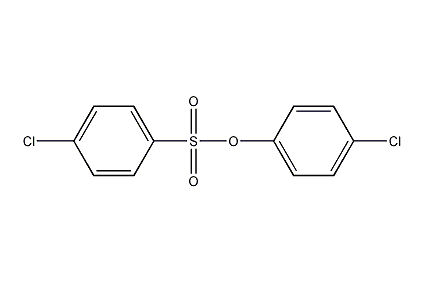
Structural formula
| Business number | 01QW |
|---|---|
| Molecular formula | C12H8Cl2O3S |
| Molecular weight | 303.16 |
| label |
p-chlorophenyl p-chlorobenzene sulfonate, Mite egg ester, Benzolsulfonate, Chlorfensin, Estonmite, 4-Chlorophenyl-4-chlorobenzenesulphenate, Acaricide |
Numbering system
CAS number:80-33-1
MDL number:MFCD00055266
EINECS number:201-270-4
RTECS number:DB5250000
BRN number:2944674
PubChem ID:None
Physical property data
1. Properties: colorless crystals. It smells fishy. There is some volatility. Stable, but can be decomposed by alkaline substances
2. Density (g/mL, 25/4℃): Undetermined
3. Relative vapor density (g/mL, Air=1): Undetermined
4. Melting point (ºC): 86.5~86.8
5. Boiling point (ºC, normal pressure): Undetermined
6. Boiling point (ºC, 5.2kPa): Undetermined
7. Refractive index: Undetermined
8. Flash point (ºC): Undetermined
9. Specific rotation (º): Undetermined
10. Autoignition point or ignition temperature (ºC): Undetermined
11. Vapor pressure (kPa, 25ºC): Undetermined
12. Saturated vapor pressure (kPa, 60ºC): Undetermined
13. Heat of combustion ( KJ/mol): Undetermined
14. Critical temperature (ºC): Undetermined
15. Critical pressure (KPa): Undetermined
16. The logarithmic value of the oil-water (octanol/water) distribution coefficient: Undetermined
17. Explosion upper limit (%, V/V): Undetermined
18. Explosion lower limit (%, V/V): Undetermined
19. Solubility: Can be mixed with almost all insecticides and fungicides. Soluble in a variety of organic solvents, insoluble in water.
Toxicological data
1. Acute toxicity
Rat caliber LD50: 2mg/kg; rat skin LD50: >10mg/kg;
Rat LD50: 2050mg/kg;
p>
Mouse caliber LD50: 1475mg/kg;
Rabbit caliber LD50: 5660mg/kg;
Pig caliber LD50: 640mg/kg;
Chicken caliber LD50: 3780mg/kg;
Bird caliber LD50: 4600mg/kg;
2. Other multiple dose toxicity data
Rat caliber TDL0: 1008 mg/kg/12W-C
Ecological data
None yet
Molecular structure data
1. Molar refractive index: 71.67
2, Molar volume (cm3/mol): 206.9
3, Isotonic specific volume (90.2K): 551.7
4. Surface tension (dyne/cm): 50.4
5. Polarizability (10-24cm3 ): 28.41
Compute chemical data
1. Reference value for hydrophobic parameter calculation (XlogP): None
2. Number of hydrogen bond donors: 0
3. Number of hydrogen bond acceptors: 3
4. Number of rotatable chemical bonds: 3
5. Number of tautomers: none
6. Topological molecule polar surface area 51.8
7. Number of heavy atoms: 18
8. Surface charge: 0
9. Complexity: 350
10. Number of isotope atoms: 0
11. Determine the number of atomic stereocenters: 0
12. Uncertain number of atomic stereocenters: 0
13. Determine the number of chemical bond stereocenters: 0
14. Number of uncertain chemical bond stereocenters: 0
15. Number of covalent bond units: 1
Properties and stability
None yet
Storage method
This product should be sealed and stored in a cool, dark place.
Synthesis method
1. Use p-chlorobenzene sulfonic acid and chlorosulfonic acid as raw materials to produce miticide through the following steps. The content of industrial products containing dicofen is over 95%. Raw material consumption quota: p-chlorobenzenesulfonic acid (92%) 1230kg/t, chlorosulfonic acid (95%) 2100kg/t, phenol (98%) 310kg/t, sodium hydroxide (95%) 157kg/t, chlorine ( 99.5%) 250kg/t, ferric chloride (99%) 1.8kg/t.
2.Using p-chlorobenzene sulfonic acid and chlorosulfonic acid as raw materials, the following steps are used to synthesize miticide.

3.Use p-chlorophenol and p-chlorobenzene sulfonyl chloride as raw materials to synthesize miticide under alkaline conditions.

Purpose
Non-systemic acaricide. Pesticide analysis standards. This product was first sold by the Swiss company Geigy as a mothproofing agent for woolen fabrics. Dicarbicide has good control effect on mite eggs and young mites, and is used to control various mites on cotton and fruit trees.
It has high activity against many plant-eating mites and eggs, with obvious residual ovicidal activity and slight insecticidal activity. It is used for various mites on cotton and fruit trees, and is generally harmless. It can also be used as a mothproofing agent for wool textiles.

 微信扫一扫打赏
微信扫一扫打赏

